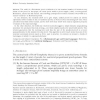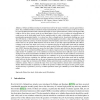265 search results - page 48 / 53 » How to Prove Inductive Theorems |
STOC
1999
ACM
14 years 22 hour ago
1999
ACM
The width of a Resolution proof is defined to be the maximal number of literals in any clause of the proof. In this paper, we relate proof width to proof length (ϭsize), in both g...
COCO
2004
Springer
13 years 11 months ago
2004
Springer
Abstract: Although a quantum state requires exponentially many classical bits to describe, the laws of quantum mechanics impose severe restrictions on how that state can be accesse...
CPC
2007
13 years 7 months ago
2007
Let G be a graph with no three independent vertices. How many edges of G can be packed with edge-disjoint copies of Kk? More specifically, let fk(n, m) be the largest integer t s...
CORR
2002
Springer
13 years 7 months ago
2002
Springer
Abstract: Although a quantum state requires exponentially many classical bits to describe, the laws of quantum mechanics impose severe restrictions on how that state can be accesse...
FSE
2011
Springer
12 years 11 months ago
2011
Springer
Abstract. Bellare and Kohno introduced a formal framework for the study of related-key attacks against blockciphers. They established sufficient conditions (output-unpredictabilit...


